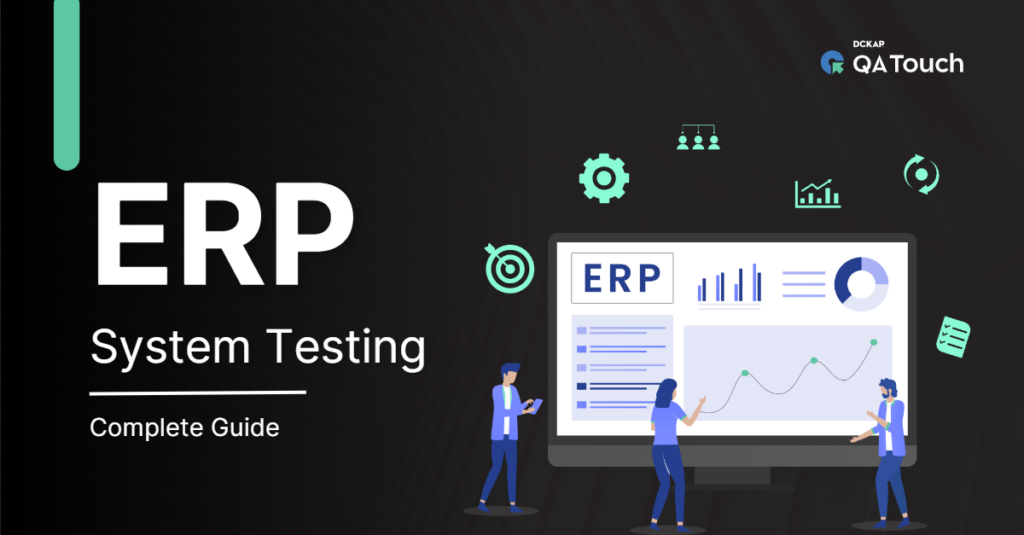Before we delve into the details of enterprise resource planning or ERP testing, let’s quickly review its definition. The reason is that there are a few misconceptions regarding ERPs and what they can do for organizations. The simplest definition, according to Microsoft, is that it integrates various business processes and functions.
In simpler terms, it can link your procurement, supply chain, finance, marketing, human resource management, and other business functions in one platform. The reason for ERP’s popularity is that it promotes efficient management of resources. Secondly, it streamlines operations as data can flow from one function to the other seamlessly.
Importance of ERP Systems in Businesses
ERPs are highly popular nowadays and every organization needs them. If you work in a WordPress development company, you can pitch the idea to the top management. The ERP system can enhance the quality of project management in the company and improve collaboration. The most commons reasons to consider an ERP system are:
1. Streamlining Operations
ERPs streamline your organization’s operations by providing a single platform to manage different business functions. Otherwise, an organization has to utilize unnecessary resources to look after each business function.
2. Data Management
A single platform allows for efficient data management. The organization can access the data from different functions and analyze it to make informed decisions. As the data is available from all the business functions in a single platform, there is synergy in decision-making.
3. Improved Resource Planning
Another reason that organizations prefer to implement an ERP is because it aides resource planning. With all the relevant data in a single system, the organization is well aware of its resources, including inventory, materials, and human capital. It helps them to reduce waste and improve resource utilization.
For example, a web design company in Pakistan or elsewhere will have multiple projects running simultaneously. The only way to ensure that each project is completed as per schedule, cost, and quality is to ensure that each project has the necessary resources. An ERP can help with resource planning and allocation.
4. Efficient Financial Management
Lastly, by automating and centralizing financial processes, an organization can accurately track its finances. It not only improves financial management but helps an organization make data-driven financial decisions.
ERP Testing
The role of ERP testing is to ensure the proper functioning of the ERP system. The testing involves multiple aspects, such as functionality, security, and performance. The purpose of ERP testing is to ensure that the platform works as desired and there are no issues that can undermine the organization’s performance.
Additionally, regular ERP testing acts as a monitoring and control mechanism. It evaluates the platform’s effectiveness by looking for errors and improvement areas. The timely identification of issues and their prompt resolution is critical to smooth organizational operations.
Types of ERP Testing
When we talk about ERP testing, it is pertinent to understand that there are different types of testing. Let’s review each.
1. Functional Testing
As the name suggests, this testing focuses on the ERP’s functionality. For instance, the purpose of your ERP system is to gather data on all organizational expenses and then prepare a management report. If it does that, then it passes the functionality test. If there are errors within the report, it indicates failure.
However, functional testing is not as easy as the above example portrays it. Instead, the test team must evaluate each workflow and process to ensure that it works as the organization or developers intends it to. Functional testing covers different areas, including the user interface and integrations with other systems.
The test team does not perform all the function tests manually. Instead, there are numerous applications available nowadays that serve this purpose. Depending on the ERP system and functionality, the team can opt for apps like Selenium, HP UFT, and TestComplete.
2. Performance Testing
The second test type is performance testing. The team usually performs it after completing the functional testing. This test measures the ERP’s systems performance-related aspects such as stability and scalability under varying workloads. For instance, how much workload can the system handle or what are the bottlenecks?
To identify if the system can handle the workload and measure other performance metrics, testers can utilize tools like LoadRunner and Apache Bench. These tools utilize virtual users to put a load on the ERP system and assess if it meets the agreed-upon performance criteria.
3. Security Testing
Nowadays, almost every organization has an ERP system. The primary reason is digitalization. While digitalization has numerous benefits for the organization and its end users, it carries certain risks. The most notable risk is cyber threats. If cybercriminals manage to gain access to an ERP system, they have all the data.
With this data, they can effectively bring an organization’s operations to a complete halt. They may demand ransom for the data or use it for other nefarious purposes. Therefore, one of the things that businesses must always focus on is their ERP system’s security.
Any unauthorized access or data breach can have far-reaching repercussions. Security testing mostly involves areas such as data encryption, access controls, and cybersecurity assessments. It is imperative that security testing is not considered a one-time thing. Instead, it must be done routinely.
4. Integration Testing
The final testing type is integration testing. In it, the test team verifies that the ERP system integrates seamlessly with other apps or databases. This test ensures that the ERP system has a proper data flow and there is interoperability. The focus is on APIs and data flow across different business functions.
Integration testing has further sub-types. The top-down testing focuses on the main module and then its sub-modules. The other type is bottom-up and it involves testing the sub-modules or sub-routines first. The big bang type considers the software as a whole rather than testing the modules or sub-modules individually.
Best Practices for ERP Testing
The previous section walked you through the different types of ERP testing. Now, let’s focus on the best practices which you must implement when undertaking ERP testing. Before you undertake the testing, allocate the necessary resources first. Ensure that the team has access to skilled professionals and the necessary tools.
1. Test Planning and Strategy
The first step is to clearly define the goals and scope of the ERP testing. It will help remove any misunderstandings and provide clarity to the team. We recommend that the test plan covers all four areas of the ERP system. By the four areas, we are referring to functionality, performance, integration, and security.
2. Set Up a Test Environment
The second step is to set up a test environment that closely resembles the real production environment. When establishing a test environment, ensure that all aspects such as the hardware, software, and data sets mirror the production environment. Otherwise, the testing may not provide accurate results.
3. Test Execution and Reporting
The next step is to execute the test cases. Ensure that you are paying extra attention here as you need to record the observations. The purpose behind the observations is to assess if the ERP is working as desired. If there are any defects, it is certainly better to identify them during the testing stage.
Furthermore, document all the test results. The documentation will serve as your lessons learned register and will be beneficial for future upgrades or implementations. The final part is reporting which involves communicating the test results to the stakeholders, including the top management.
4. Test Automation
Lastly, invest in test automation tools. It will not only speed up the testing process but allow you to carry it out routinely. It ensures that your ERP performs at the same level throughout its lifecycle. Automation also improves test coverage.
Challenges and Solutions in ERP Testing
ERP testing is certainly not without its challenges. There are numerous issues that an organization is likely to face during ERP testing. They include:
1. Data Management
The first challenge is handling large volumes of test data. As said earlier, the test environment needs to closely mirror the real environment. Therefore, real data should be utilized. The best way to deal with this challenge is first to define the data integrity rules. The second step is to validate the data and ensure that it is consistent.
As the data closely mirrors the real data, it is quite likely that the test team may be working on highly sensitive data. If your own in-house team is working on the testing and they are authorized to access the data, then it is not an issue. However, if it is a third party or the team doesn’t have the credentials to access the data, anonymize it.
2. Test Environment Complexity
The second most notable challenge is dealing with the integrations and setting up the test environment. The best way to deal with it is by implementing virtualization and containerization technologies. It will ensure that there is no outside interference from other factors and greatly improve the accuracy of your tests.
3. Regression Testing
It is not necessary that an organization is undertaking ERP testing because it recently implemented a new ERP. In some cases, a business may only undertake upgrades to the functionality. In such a case, undertaking regression testing becomes a hassle. This testing involves ensuring that the ERP is not compromised after the modifications.
The only way to overcome this challenge is by first identifying which areas are most likely to be affected by the modifications or upgrades. You will need to utilize your most experienced professionals for this purpose. Then prioritize the areas based on impact to improve the test quality and save valuable resources.
4. Test Data Security
Due to the growing threat of data breaches and leaks, data security deserves a separate mention. It is imperative for organizations to not only define but also implement strict security controls. It will ensure that the data is secure throughout the testing phase, including during the transmission.
Conclusion
ERP systems play a critical role in helping organizations streamline their operations. With the organizational data stored and available on a single platform, informed decision-making has never been easier. However, implementing an ERP system is only the first step.
Organizations must ensure that the system works as intended and adds to the organization’s effectiveness rather than woes. It is here that ERP testing comes into play. As the discussion shows, there are different types of ERP testing and each one tests a different aspect of the ERP system.
It is essential for organizations to incorporate the best practices and leverage appropriate tools for ERP testing. It will not only save valuable resources but greatly improve the quality of the ERP testing. Lastly, there must be a focus on continuous improvement to maximize the benefits of ERP systems.







